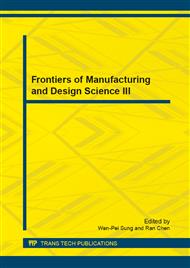p.222
p.227
p.232
p.237
p.242
p.247
p.251
p.255
p.259
Residual Stresses in Prestressed Turning of Nickel-Based Superalloy
Abstract:
Aiming to get appropriate residual compressive stress distribution on machined surface just in the machining process, the technique of prestressed cutting is applied for nickel-based superalloy shafts. This article studies theoretically and experimentally the effect of prestress on the residual stress in the machined surface layer. Prestressed turning tests under the conditions of different prestress, cutting speed, depth of cut and feed rate were carried out, residual stresses were determined via an X-ray diffraction technique. Theoretical result demonstrates that higher prestress leads to more prominent residual compressive stress and validated by experiments, meanwhile measured residual stress profiles indicate that lower cutting speed and lower feed rate lead to more remarkable compressive stress state, contrarily depth of cut shows relatively indistinctive effect.
Info:
Periodical:
Pages:
242-246
Citation:
Online since:
December 2012
Authors:
Price:
Сopyright:
© 2013 Trans Tech Publications Ltd. All Rights Reserved
Share:
Citation:


